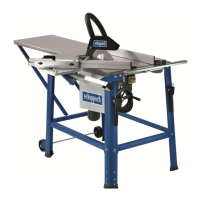20
Tool: Circular sawblade for longitudinal cuts
Operating cycle: Adjust the fence in accordance with the
width of the workpiece. Feed the workpiece with both
hands (use the push-stick in the region of the sawblade)
and push the workpiece until it is behind the riving knife.
Use the push-stick to feed the workpiece right from the
beginning of the cutting process if short workpieces are
being used.
Cutting edges and strips, Fig. C
Tool: Circular sawblade for a fine cut
Operating cycle: Mount the fence with a low stop bar sur-
face or use an auxiliary fence. Feed the workpiece with a
push-stick until the end of the workpiece is in the region
of the riving knife. Prevent long workpieces from toppling
over at the end of the cutting process by using a table
length extension.
Note: Devices which must be connected to parts of the
machine are to be secured with screws. Thumb screws
can only be used to make temporary connections at ma-
chines.
Cross-cutting narrow workpieces, Fig. D
Tool: Fine-toothed crosscut blade
Operating cycle: Adjust the rejection rail so that workpiece
sections do not touch the ascending part of the sawblade.
Only feed the workpiece by means of a crossfeed stop or
a cross slide.
Do not remove wood chippings from the region of the
workpiece with your hands.
m
Electrical Connection
The electric motor is connected in a ready-to-operate
state. The connection corresponds to the relevant VDE
and DIN regulations.
The mains connection at the customer’s work place and
the extension cable used must correspond to these regula-
tions.
Important information
The 230 V / 50 Hz electric motor is designed for the S6 /
40% (400 V/50 Hz S6/40%) operating mode.
The motor automatically switches off if it is overloaded.
The motor can be switched on again after a cooling-down
period (varies timewise).
Faulty electrical connecting leads
Insulation damage often occurs at electrical connecting
leads.
Causes include:
• Pressure marks caused when connecting leads are run
through windows or the cracks of doors.
• Folds caused by the improper attachment of running of
the connecting leads.
• Cutsresulting from the crossing of the connecting lead.
• Insulation damages caused by the ripping out of the
connecting lead from the wall socket.
• Cracks due to the ageing of the insulation.
Faulty electrical connecting leads such as these may not
be used and are highly dangerous due to the insulation
damage.
Check electrical connecting leads regularly for damage.
Ensure that the connecting lead is not attached to the
mains supply when you are checking it.
Electrical connecting leads must correspond to the rele-
vant VDE and DIN regulations. Only use connecting leads
with the code H 07 RN. The type designation must be
printed on the connecting lead by regulation.
Single-phase motor
• The supply voltage must be 230 volt – 50 Hz.
• Extension leads up to 25 m in length must have a cross-
section of 1.5 mm
2
. Extension leads whose length is
over 25 m must have a cross-section of at least 2.5
mm
2
.
• The mains connection is fused with a 16 A slow-blow
fuse.
Three-phase motor
• The mains voltage must coincide with the voltage speci-
fied on the motor’s rating plate.
• The mains connection and the extension cable must
have 5 conductors: 3 phase conductors + 1 neutral con-
ductor + 1 earth conductor.
• The extension cable must have a minimum cable cross-
section of 1.5 mm2.
• The connection to the mains must be protected with a
16 A slow-acting fuse.
• The rotating direction must be checked when the
machine is connected to the mains or re-sited. If
necessary, the polarity will have to be changed over
(wall socket).
Connections or repairs on the electrical equipment may only
be carried out by an electrician.
Please give the following information if you have any en-
quiries.
• Motor manufacturer
• Kind of current
• Machine type label data
If your are sending back the motor, always send the com-
plete drive unit with the switch.
• The product meets the requirements of EN 61000-3-
11 and is subject to special connection conditions. This
means that use of the product at any freely selectable
connection point is not allowed.
• Given unfavorable conditions in the power supply the
product can cause the voltage to fluctuate temporarily.
• The product is intended solely for use at connection
points that
a) do not exceed a maximum permitted supply imped-
ance “Z”, or
b) have a continuous current-carrying capacity of the
mains of at least 100 A per phase.

